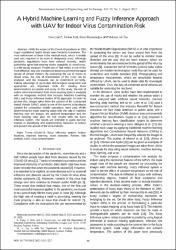A hybrid machine learning and fuzzy inference approach with UAV for indoor virus contamination risk
Citation
Çakır, E., Erdi, F., Demircioğlu, E., Taş, Mehmet A. (2023). A hybrid machine learning and fuzzy inference approach with UAV for indoor virus contamination risk. International Journal of Engineering and Technology, 15 (3).Abstract
With the impact of the Covid-19 pandemic in 2020,
major established health rituals were forced to transform. The
most well-known of these is the medical mask, which is widely
used and required to be worn in designated areas. Although
pandemic regulations have been relaxed recently, health
authorities agree that wearing masks, especially in closed areas,
is a life-saving measure. Proper use of face masks is one of the
most effective, easy and inexpensive actions to prevent the rapid
spread of viruses indoors. By examining the use of masks in
closed areas, the risk of transmission of the virus can be
analyzed, and the measures can be determined correctly.
Taking advantage of up-to-date technological equipment and
approaches are important tools for making these
determinations accurately and easily. In this study, the risk of
indoor virus transmission from mask wearing styles is analyzed
with an integrated method that includes Machine Learning
(ML) and Fuzzy Inference System (FIS) approach. In order to
achieve this, images taken from the camera of the Unmanned
Aerial Vehicle (UAV), which is one of the current technologies
suitable for contactless, mobile operations, were used. While
determining the mask wearing status with the help of machine
learning over the images, the ambient temperature and the
mask wearing ratio gave the risk results with the fuzzy
inference system. The results are intended to guide decision
makers in identifying and implementing measures to reduce
and prevent the spread of the virus indoors.

















